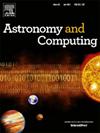That pesky A-term: Efficiently correcting for direction-, time-, and baseline-dependent effects in radio interferometric imaging
IF 1.8
4区 物理与天体物理
Q2 ASTRONOMY & ASTROPHYSICS
引用次数: 0
Abstract
Radio interferometers must grapple with apparent fields of view that distort the true radio sky. These so-called ‘-term’ distortions may be direction-, time- and baseline-dependent, and include effects like the primary beam and the ionosphere. Traditionally, properly handling these effects has been computationally expensive and, instead, less accurate, ad-hoc methods have been employed. Image domain gridding (idg; van der Tol et al., 2018) is a recently developed algorithm that promises to account for these -terms both accurately and efficiently. Here we describe a new implementation of idg known as the Parallel Interferometric gpu Imager (Pigi). Pigi is capable of imaging at rates of almost half a billion visibilities per second on modest hardware, making it well suited for the projected data rates of the Square Kilometre Array, and is compatible with both nvidia and amd gpu hardware. Its accuracy is principally limited only by the degree to which -terms are spatially sampled. Using data from the Murchison Widefield Array, we demonstrate the effectiveness of Pigi in correcting for simulated ionospheric effects and point to future work that would enable these results on real-world data.
恼人的a术语:在无线电干涉成像中有效地校正方向、时间和基线相关的影响
无线电干涉仪必须与扭曲真实无线电天空的视场作斗争。这些所谓的“A-term”扭曲可能与方向、时间和基线有关,包括像主波束和电离层这样的影响。传统上,正确地处理这些影响在计算上是昂贵的,并且采用了不太精确的特殊方法。图像域网格(idg; van der Tol等人,2018)是最近开发的一种算法,有望准确有效地考虑这些a项。在这里,我们描述了idg的一种新实现,称为并行干涉图形处理器成像仪(Pigi)。Pigi能够在普通硬件上以每秒近5亿次可见性的速率成像,使其非常适合平方公里阵列的预计数据速率,并且与nvidia和amd gpu硬件兼容。它的准确性主要受限于a项在空间上采样的程度。利用默奇森宽场阵列的数据,我们证明了Pigi在校正模拟电离层效应方面的有效性,并指出未来的工作将使这些结果适用于现实世界的数据。
本文章由计算机程序翻译,如有差异,请以英文原文为准。
求助全文
约1分钟内获得全文
求助全文
来源期刊

Astronomy and Computing
ASTRONOMY & ASTROPHYSICSCOMPUTER SCIENCE,-COMPUTER SCIENCE, INTERDISCIPLINARY APPLICATIONS
CiteScore
4.10
自引率
8.00%
发文量
67
期刊介绍:
Astronomy and Computing is a peer-reviewed journal that focuses on the broad area between astronomy, computer science and information technology. The journal aims to publish the work of scientists and (software) engineers in all aspects of astronomical computing, including the collection, analysis, reduction, visualisation, preservation and dissemination of data, and the development of astronomical software and simulations. The journal covers applications for academic computer science techniques to astronomy, as well as novel applications of information technologies within astronomy.
 求助内容:
求助内容: 应助结果提醒方式:
应助结果提醒方式:


